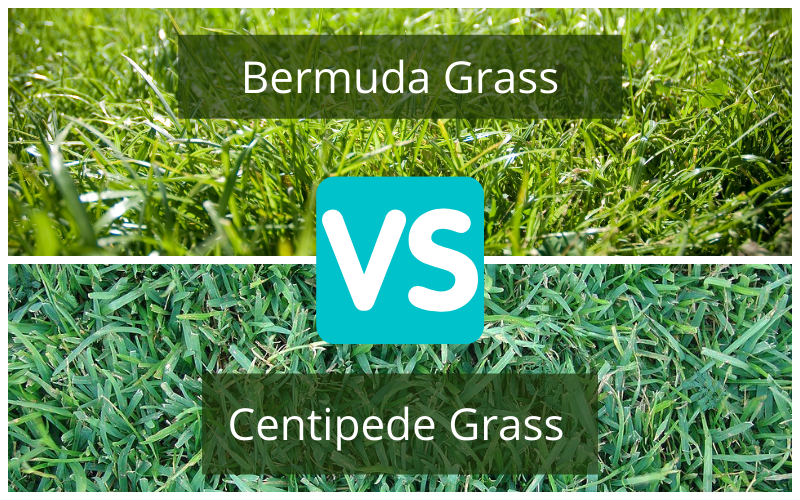Centipede grass and Bermuda grass are both low-growing grasses that produce stolons or “above-ground roots” that branch out and create a network of grass clumps. They both take several years to form a lawn and have many other similarities. However, there are a few key things to take into account before you choose one over the other despite these many commonalities.
Comparing Centipede Grass vs Bermuda Grass
Centipede grass and Bermuda grass have three big differences: resource needs, appearance, and temperature needs. Before you choose one over the other, you should decide what your lawn and climate can offer and what sort of appearance you want your lawn to have. Below is a breakdown of all of these specific differences and how much of a difference they can make for a lawn.
Appearance
What is the difference between Bermuda and Centipede grass in appearance? Centipede grass is light green and fine with no hairs near the leaf sheaths on each stolon (above-ground root). Bermuda grass is medium to dark green with fine hairs near the base of each leaf sheath. Centipede grass is also considered a coarse grass type, but it’s still much finer than Bermuda grass.
Best Uses for Centipede Grass and Bermuda Grass
Centipede grass is best for a lawn on terrain with a low pH and poor, sandy soil. This grass type is water smart and will do very well with only .5” of water each week. This is considered the ultimate low-maintenance grass type for a reason. Overall, Centipede grass is best for a low-traffic and ultra-low-maintenance lawn.
Bermuda grass, on the other hand, is also great for sandy soil but it requires much higher nutrient content in the soil. It needs average to slightly above-average amounts of water at 1″ to 1.5″ each week. Bermuda grass can also take slightly more traffic than centipede grass. Overall, Bermuda is suitable for most average lawn needs on a rich, sandy foundation.
Soil Types and pH Needs of Centipede Grass and Bermuda Grass
Both centipede grass and Bermuda grass prefer sandy, well-drained soil. Most stolon-producing grass types prefer this type of soil as it is very difficult for stolons to break through clay or any hard-packed soil.
Both grass types also prefer an acidic pH. Centipede’s ideal pH is 5 to 6 while Bermuda grass likes a pH of 6 to 7. For both, it’s always better to err on the acidic side to speed up growth and avoid diseases.
Water Needs for Centipede Grass vs Bermuda Grass
Centipede grass requires a low .5” to 1” of water each week. That can mean running sprinklers for as little as 5 minutes a week. As far as grasses go, centipede grass is considered very “water smart”. Bermuda grass has a more average water consumption of about 1” to 1.5” each week.
If overwatered, both centipede grass and Bermuda grass can become susceptible to root-rot as well as fungal infections and mold. If there is standing water on a lawn, be careful not to damage the grass as it will have a harder time recovering in wet weather.
Sun, Shade, and Temperature Requirements for Centipede Grass and Bermuda Grass
Both Centipede grass and Bermuda grass require full sun to grow at their best. However, while Centipede grass won’t die in partial, intermittent shade, Bermuda grass may die back to the edges of where the shade begins, even if it’s only in shade for part of the day.
Centipede grass needs very warm temperatures to survive. It can begin taking damage if temperatures drop below 50F and may die off completely if it’s allowed to freeze. Bermuda grass will not die if it freezes, but it will go completely dormant. Unlike other warm-season grass types, Bermuda grass can retain its healthy green color at temperatures below 55F and as low as 45F, even though it has stopped growing completely.
Durability of Centipede Grass vs Bermuda Grass Lawns
Centipede grass and Bermuda grass both produce stolons. All stolon-based grass types take a lot longer to grow than grass that typically reproduces from seed or rhizomes. Once they do, the lawn may feel a little different as it is more of a “mat” of grass than most sod types. It should take 2 to 3 years for either a Centipede or Bermuda grass lawn to be fully established.
Once it is established, Centipede grass doesn’t gain much durability. It is still easily crushed, dug up, or harmed by excessive moisture. Centipede grass should only be used for low-traffic lawns and is never ideal for pets.
Bermuda grass, once established, has a decent amount of durability as long as it is healthy and the soil is both rich and well-drained. Though not ideal for pets or high traffic, Bermuda makes a decent grass type for most average lawns.
Common Pests and Diseases for Centipede Grass Lawns and Bermuda Grass Lawns
Digging pets, grubs and other lawn-destroying insects, mold, and fungus are all common pests and diseases that owners of both Centipede grass lawns and Bermuda grass lawns have to deal with. While establishing, Centipede grass lawns also need to be protected from weeds that may easily crowd out these slow-growing clumps of Centipede grass. Bermuda grass, however, is better at holding its ground and eventually overtaking small, low-growing weeds.
Mowing Needs of Centipede Grass and Bermuda Grass Lawns
Both Centipede grass and Bermuda grass will likely only need to be mown once a week in the hot seasons and less once temperatures drop below 70F. As low-growing stolon-producing grass types, neither Centipede grass nor Bermuda grass will need to be dethatched often, with this process needing to take place only once a year or even every other year.
Types of Grass Related to Centipede Grass
Centipede grass doesn’t have many close relatives but does have some advantages if you look into different strains of Centipede grass. There is, of course, the classic and it comes with many well-documented advantages and disadvantages but the patented genotype cultivars on offer for your region may have improved texture, cold resilience, density, and more.
Types of Grass Related to Bermuda Grass
Bermuda grass also has few relatives with similar characteristics. Of the cultivated varieties on offer, some can improve the texture of the grass and even improve its root depth and heartiness, decreasing the likelihood of damage or death from wear and tear.
The Best-Case-Scenario for a Centipede Grass or Bermuda Grass Lawn
Which is better, centipede or Bermuda grass? With similar needs, the choice between Centipede grass and Bermuda grass comes down to appearance and durability. Centipede grass is lighter in color, has a decent texture, and has less durability. However, it does a little better in the hottest weather (temperatures above 90F) and can handle a drought for longer without discoloring. Bermuda grass is coarser, more durable, and darker in color. Thought it needs slightly lower temperatures and slightly more water to thrive.
A Quick Summary of Centipede Grass vs Bermuda Grass
If you want to be able to quickly reference the differences between Centipede Grass vs Bermuda Grass and the optimal conditions for each, I’ve put together the table below.
| Grass Type | Centipede Grass | Bermuda Grass |
|---|---|---|
| Appearance | Bright, Light Green with Short, Straight Blades Growing From Long Stolons | Dark Green with a Coarse Texture – Small Hairs on Leaf Sheath - Stolons |
| Popular Uses | Warm Climate Lawns with Low Traffic and Few Resources | Warm to Hot Climate with Average Traffic |
| Ideal Soil Type and pH | Sandy and Dry Soil is Ideal - 5 to 6 Ideal pH | Well-Drained and Rich Soil is Ideal - 6 to 7 Ideal pH |
| Water Requirements | .5 to 1” of Water Per Week – Low to Average Overall Water Consumption | 1” to 1.5” of Water Per Week – Average Overall Water Consumption |
| Sun/Shade/Temperature Needs | Full Sun Preferred/No True Dormant Period | Full Sun Required – True Dormancy at 32F – Stopped Growth Below 55F |
| Durability | Low Durability and Damage Recovery | Average Durability and Recovery |
| Pests and Diseases | Mold, Mildew, Moss, and Algae if Too Moist – Webworms, Thrips, Grubs – Digging Animals – Weeds and Other Plants | Mold, Mildew, Moss, and Algae if Too Moist – Webworms, Thrips, Grubs – Digging Animals |
| Mowing Needs | Should Be Mown to 1” to 1.5” Height – Grows Best in Hot Weather | Should Be Mown to 1.5” to 2.5” On Average – Grows Best in Warm to Hot Weather |



Leave a Reply